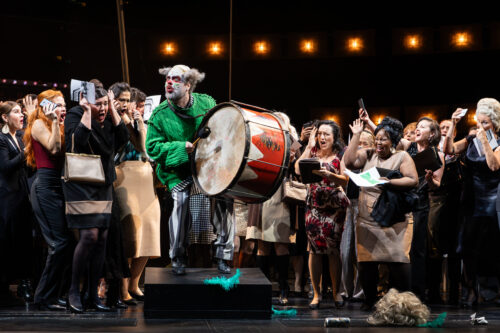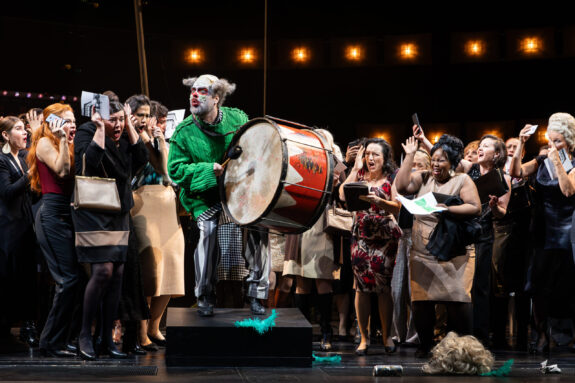 Germany Leoncavallo, Pagliacci: Soloists, Chorus and Extras of Staatsoper Hannover, Niedersächsisches Staatsorchester Hannover / Mario Hartmuth (conductor). Staatsoper Hannover, 3.11.2024. (DMD)
Germany Leoncavallo, Pagliacci: Soloists, Chorus and Extras of Staatsoper Hannover, Niedersächsisches Staatsorchester Hannover / Mario Hartmuth (conductor). Staatsoper Hannover, 3.11.2024. (DMD)

Production:
Director – Dirk Schmeding
Stage design – Ralf Käselau
Costume design – Pascal Seibicke
Lighting design – Johannes Volk
Video – Philipp Contag-Lada
Choreography – Annika Dickel
Chorus director – Lorenzo Da Rio
Dramaturgy – Therese Steinacker
Cast:
Tonio – Daniel Scofield
Canio – Viktor Antipenko
Nedda – Barno Ismatullaeva
Beppe – Paweł Brożek
Silvio – Darwin Prakash
On this occasion, Pagliacci was shown on its own, making the 75-minute opera an ideal part of the early-start / early finish ‘after work’ series of performances for Hannover State Opera’s 2024/25 season.
According to dramaturg Therese Steinacker’s comments in the audio intro on the production website, the main idea is the flexible boundaries between real life (that of the troupe and the spectators) and the life depicted in the play. Thus, Canio never leaves the world of the play: he is always in his clown’s costume and his face is always made up accordingly. He does not sit in front of a mirror, putting on his mask, while singing the famous aria ‘Vesti la giubba’.
This idea may not be new or original, but it remains interesting. However it was not supported by the set in this case. Rather than a troupe coming to a village to perform, an exciting event for the locals, spectators (from where?) gathered on the troupe’s own grounds. Troupe and groups were equally rundown. There was a piano perched precariously on the slope down the side of what looked like a sinkhole, there was a box office trailer and there was a shabby raised area on which the spectators are placed later, on plastic garden chairs which the chorus members (playing the spectators) bring on to the stage. While the bright colours of some of the costumes provided some contrast, the overall impression remained dreary. We saw problem-ridden characters in a cheerless environment.
A large balloon-like structure was lowered into view from above and lifted out of view again. On to it was projected the bearded face of a male clown, looking somewhat like a nightmare version of Pavarotti made up as Canio, talking in Italian, complete with transmission errors such as flickering or interference noises.

In addition, the arrangement of the set meant that troupe members and spectators had to clamber about on the stage to get from one place to the other. This looked chaotic – very realistically so but improvised. Well-choreographed chaos can be (part of) a work of art, even a great one – improvised chaos rarely so.
Conductor and soloists had to work against the set und the setting since they were not allowed to work with them. Hannover State Opera’s new Kapellmeister, Mario Hartmuth, equated passion with robust volume at the expense of a subtler, more nuanced reading. Fortunately, the soloists’ voices were strong enough to cope with that volume: none was in danger of being drowned out. The role of Canio suited Viktor Antipenko’s spinto tenor voice very well. He was able to modulate volume at will, reached exposed high notes with ease, and rounded off long-held notes smoothly rather than abruptly as if out of breath. Daniel Scofield convincingly combined the impressive melodrama of the prologue with a character study of Tonio in the material that followed. Paweł Brożek was a very enjoyable Beppe, making good use of his flexible buffo tenor. Darwin Prakash presented Silvio as a credible rival for Nedda’s love, coming across as very confident by virtue of his acting and sonorous voice. Barno Ismatullaeva was delightful as Nedda, sometimes playful, sometimes moody, altogether dissatisfied with her life and happy to escape with Silvio. Her agile voice emphasised this confidently across all registers, clear, bright and with ringing top notes.
Daniel Meyer-Dinkgräfe
